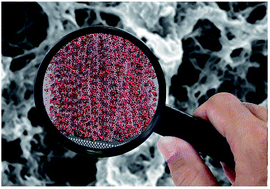Resolving the subnanometric structure of ultrathin films of poly(3,4-ethylenedioxythiophene) on steel surfaces: a molecular modeling approach†
Abstract
Poly(3,4-ethylenedioxythiophene), abbreviated PEDOT, is one of the most outstanding electroactive polymers, whose applications cover a wide range of fields from biomedicine to electronic components. In this work the physicochemical properties of nanoconstructs obtained by growing PEDOT chains over steel surfaces are investigated. The structural features of such nanostructures, which had successfully been used to build supercapacitors, are investigated, revealing that the polymeric phase plays a key role in the charge accumulation process. The ultra-structure organization and dynamics of these constructs are explored by molecular simulations and the results are compared with the available experimental data. The outcome of this investigation has offered a detailed vision of the structural features that lead to an extraordinarily efficient charge accumulation. Atomistic models generated using stochastic methods had provided different distributions of polymer chains over a metallic surface. Molecular dynamics simulations performed on such models have demonstrated that the extraordinary capacity for charge accumulation stems from a thin balance between the electrostatic repulsion that polymer chains exercise to each other and the attraction that the counterions present in the electropolymerization exert on those oxidized PEDOT chains. This situation favors the aggregation of the PEDOT chains mediated by the perchlorate ions, which act over them as inter-chain cement and which leads to regular three dimensional organization of chains, regardless of their initial distribution over the metallic surface. At the same time, such inner proximity of the polymer chains when growing upwards forces the capture of perchlorate ions, acting as accumulated charges that could be further released if the PEDOT oxidation state is externally reversed.


 Please wait while we load your content...
Please wait while we load your content...